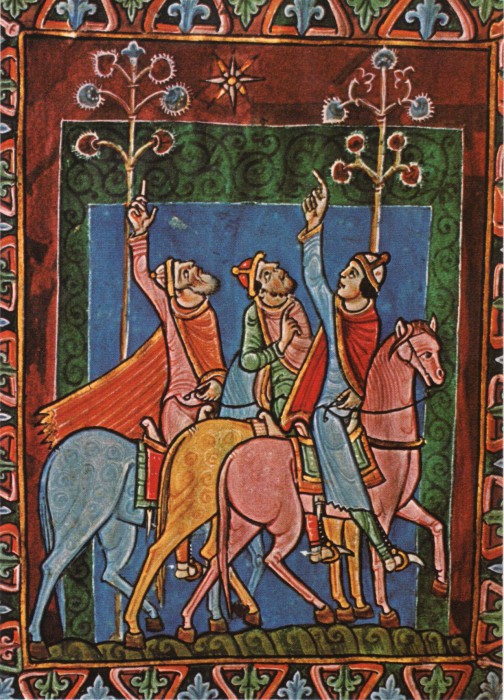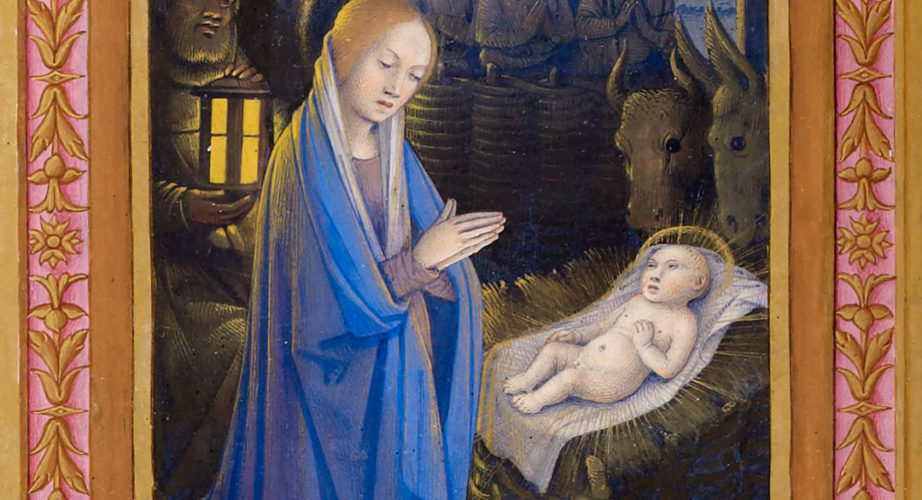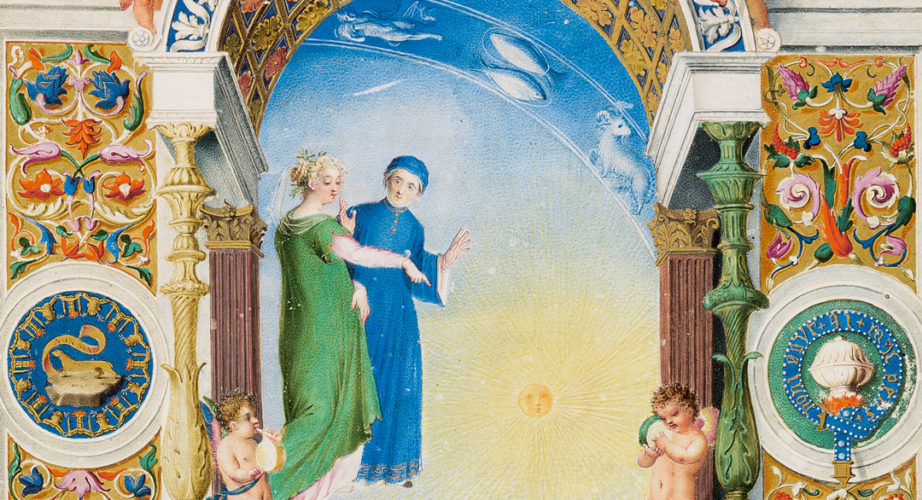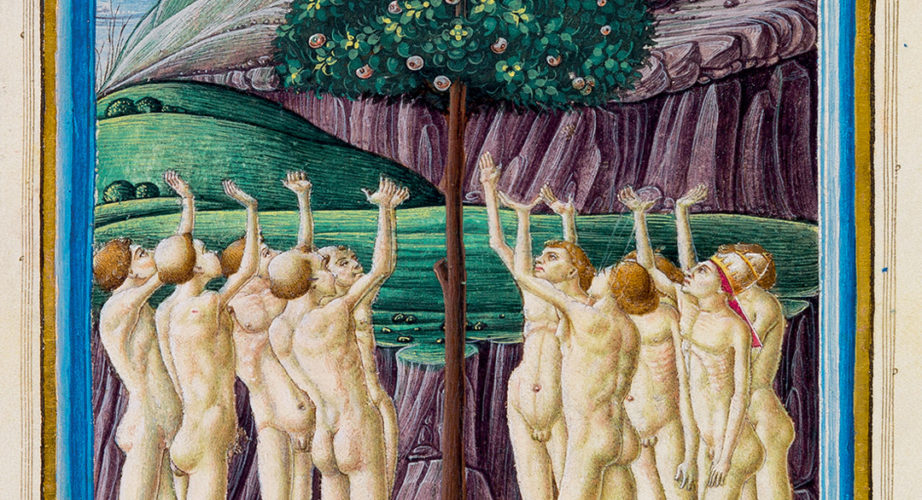I RE MAGI – LA TECNICA PITTORICA DELLA TEMPERA AD UOVO
 The Three Magi from the St. Albans Psalter, English, 12th century.
TECNICHE PITTORICHE DELLO STILE ROMANICO
I dipinti prodotti con tempera di uova - in cui il pigmento era mischiato con acqua e uova prima dell'applicazione - erano molto diffusi nel XIII secolo. La parte proteica dell'uovo, una volta che l'acqua era evaporata, legava il pigmento al substrato.
La tendenza di uno strato spesso di un dipinto a spaccarsi significava che era necessario applicare la pittura in strati o patine più sottili. L'artista procedeva con le correzioni, per questo la coloritura finale dei dipinti risultava estremamente definita e accurata.
PALETTE
I pigmenti minerali (rosso ocra, giallo ocra, terra d'ombra, bianco lime) continuavano a essere usati dai pittori durante il Medioevo. Modellando i pigmenti a forma di bastoncino e incidendoli con dei coltelli, i pittori creavano gessetti pronti per disegnare. I gessetti rossi naturali, con il loro colore ricco e caldo, furono popolari dal 1500 al 1900. Artisti come Michelangelo, Rembrandt e Antoine Watteau usarono questo mezzo per produrre alcuni dei loro dipinti più significativi .
I pittori medievali Italiani usavano il verde terra, disponibile fin dall'antichità, per i toni color carne. Si usava anche il sinonimo verde Verona, dalla città italiana. Erano usati per il colore verde anche la malachite e il verdigris (un pigmento ottenuto dall'ossidazione del rame).
In aggiunta all'azzurrite - un minerale, della famiglia dei carbonati - utilizzato come blu dal tempo degli antichi Egizi, il più importante blu nel Medioevo era l'ultramarino. Durante il Rinascimento, il colore blu era associato alla purezza e l'ultramarino era usato per colpire e fare effetto nei dipinti di Maria Vergine , in cui era rappresentata quasi sempre indossando abiti di colore blu ultramarino. Il prezzo elevato del pigmento, le cui fonti naturali erano situate in Afghanistan, indicava che il suo uso era appropriato nel caso di un soggetto nobile, come, appunto, la madre del Cristo.
PAINTING TECHNIQUES OF THE HIGH ROMANESQUE STYLE
The Three Magi from the St. Albans Psalter, English, 12th century.
TECNICHE PITTORICHE DELLO STILE ROMANICO
I dipinti prodotti con tempera di uova - in cui il pigmento era mischiato con acqua e uova prima dell'applicazione - erano molto diffusi nel XIII secolo. La parte proteica dell'uovo, una volta che l'acqua era evaporata, legava il pigmento al substrato.
La tendenza di uno strato spesso di un dipinto a spaccarsi significava che era necessario applicare la pittura in strati o patine più sottili. L'artista procedeva con le correzioni, per questo la coloritura finale dei dipinti risultava estremamente definita e accurata.
PALETTE
I pigmenti minerali (rosso ocra, giallo ocra, terra d'ombra, bianco lime) continuavano a essere usati dai pittori durante il Medioevo. Modellando i pigmenti a forma di bastoncino e incidendoli con dei coltelli, i pittori creavano gessetti pronti per disegnare. I gessetti rossi naturali, con il loro colore ricco e caldo, furono popolari dal 1500 al 1900. Artisti come Michelangelo, Rembrandt e Antoine Watteau usarono questo mezzo per produrre alcuni dei loro dipinti più significativi .
I pittori medievali Italiani usavano il verde terra, disponibile fin dall'antichità, per i toni color carne. Si usava anche il sinonimo verde Verona, dalla città italiana. Erano usati per il colore verde anche la malachite e il verdigris (un pigmento ottenuto dall'ossidazione del rame).
In aggiunta all'azzurrite - un minerale, della famiglia dei carbonati - utilizzato come blu dal tempo degli antichi Egizi, il più importante blu nel Medioevo era l'ultramarino. Durante il Rinascimento, il colore blu era associato alla purezza e l'ultramarino era usato per colpire e fare effetto nei dipinti di Maria Vergine , in cui era rappresentata quasi sempre indossando abiti di colore blu ultramarino. Il prezzo elevato del pigmento, le cui fonti naturali erano situate in Afghanistan, indicava che il suo uso era appropriato nel caso di un soggetto nobile, come, appunto, la madre del Cristo.
PAINTING TECHNIQUES OF THE HIGH ROMANESQUE STYLE
Egg tempera painting, in which the pigment was mixed with water and egg before application, was well established by the 13th century. The dried protein remaining after the water evaporated bound the pigment to the substrate. The tendency of a thick layer of such paint to crack meant that it was essential to apply the paint in thin layers or glazes, and is the reason for the highly finished appearance of medieval paintings.
PALETTE
Post consigliati
Buone Feste da Folia Magazine!
Con questa dolcissima Natività a lume di lanterna, Folia Magazine augura a tutti…
Viaggio nel Dante Urbinate: Paradiso, Canto I. Dante e Beatrice
Il frontespizio del Paradiso si presenta come una complessa e nello stesso tempo…
Viaggio nel Dante Urbinate: Purgatorio, Canto XXIV. L’albero della temperanza
Continua il viaggio dei tre poeti lungo il Purgatorio, siamo giunti nella sesta…


